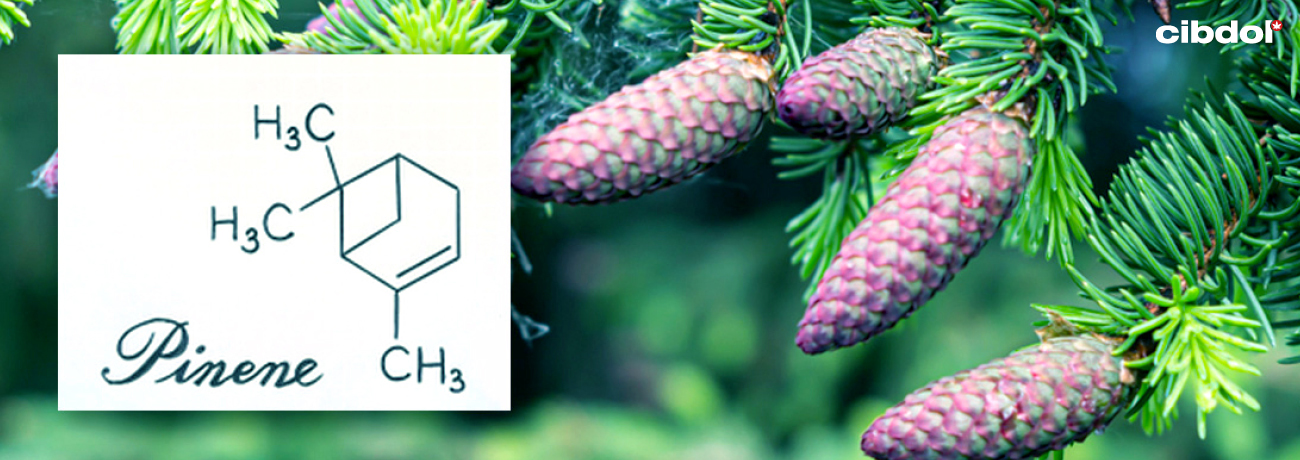What Is Pinene?

Pinene is a major terpene common to the Cannabis sativa species. Terpenes are aromatic compounds found in hundreds of foods and plants. Pinene has two structural isomers with minor variations, alpha-pinene and beta-pinene, which appear in conifers and other woodland trees. Pinene forms part of a plant’s natural defences, repelling insects with its distinct aroma. Once extracted and isolated, pinene is also used in perfumes and industrial cleaners.
Aroma
Alpha-pinene’s aroma is similar to pine trees and rosemary. Beta-pinene gives off a scent similar to hops or basil.
Also found in
Conifers, oranges, rosemary, dill, and parsley.

Supporting research
Many of the studies involving pinene have been conducted on animal models, or are still in preclinical stages. The compound appears to have a broad influence, with results demonstrating possible antimicrobial, anti-inflammatory, anti-tumour, and memory-enhancing capabilities.
A 2007 study in the Brazilian Journal of Pharmaceutical Sciences tested the antimicrobial action of α-pinene and β-pinene. Against gram-positive bacteria, the two compounds showed “total elimination of the bacteria inoculum in a maximum time of 24 hours of exposure”. Researchers concluded that pinene has a “possible and rational use in antimicrobial therapy”[1].
On the basis of previous studies, a study in the Journal of Natural Products sought to further understand the anti-inflammatory action of pinene. When compared against other compounds within the “pinane nucleus”, pinene was the most potent at inhibiting inflammatory and catabolic pathways[2].
In a 2006 study published in Bioscience, Biotechnology, and Biochemistry, researchers extracted pinene from the needles of Korean fir to test cognitive performance in mice. Mice administered with the essential oil showed a memory enhancement of 72.7% compared to the control group. Both groups were tested using induced amnesia, which can be compared to the impact of Alzheimer's and vascular dementia[3].
A test conducted both in vivo and in vitro showed that α-pinene could have anti-tumour properties. The Journal of Pharmacological Sciences indicated that liver cancer cell growth was inhibited by up to 79.3%. The study was based on pine needle oil, used in traditional Chinese medicine as an anticancer agent[4].
Safety and side effects
To date, there is little evidence to suggest pinene produces adverse side effects. However, research is ongoing, and there is still much to learn about the possible positive and negative effects of terpenes on the human body.
[1] Leite, A. M., Lima, E. D. O., Souza, E. L. D., Diniz, M. D. F. F. M., Trajano, V. N., & Medeiros, I. A. D. (2007). Inhibitory effect of beta-pinene, alpha-pinene and eugenol on the growth of potential infectious endocarditis causing Gram-positive bacteria. Revista Brasileira de Ciências Farmacêuticas, 43(1), 121–126. https://doi.org/10.1590/s1516-93322007000100015 [Source]
[2] Rufino, A. T., Ribeiro, M., Judas, F., Salgueiro, L., Lopes, M. C., Cavaleiro, C., & Mendes, A. F. (2014). Anti-inflammatory and Chondroprotective Activity of (+)-α-Pinene: Structural and Enantiomeric Selectivity. Journal of Natural Products, 77(2), 264–269. https://doi.org/10.1021/np400828x [Source]
[3] KIM, K., BU, Y., JEONG, S., LIM, J., KWON, Y., CHA, D. S., KIM, J., JEON, S., EUN, J., & JEON, H. (2006). Memory-Enhancing Effect of a Supercritical Carbon Dioxide Fluid Extract of the Needles ofAbies koreanaon Scopolamine-Induced Amnesia in Mice. Bioscience, Biotechnology, and Biochemistry, 70(8), 1821–1826. https://doi.org/10.1271/bbb.50608 [Source]
[4] Chen, W., Liu, Y., Li, M., Mao, J., Zhang, L., Huang, R., Jin, X., & Ye, L. (2015). Anti-tumor effect of α-pinene on human hepatoma cell lines through inducing G2/M cell cycle arrest. Journal of Pharmacological Sciences, 127(3), 332–338. https://doi.org/10.1016/j.jphs.2015.01.008 [Source]
[1] Leite, A. M., Lima, E. D. O., Souza, E. L. D., Diniz, M. D. F. F. M., Trajano, V. N., & Medeiros, I. A. D. (2007). Inhibitory effect of beta-pinene, alpha-pinene and eugenol on the growth of potential infectious endocarditis causing Gram-positive bacteria. Revista Brasileira de Ciências Farmacêuticas, 43(1), 121–126. https://doi.org/10.1590/s1516-93322007000100015 [Source]
[2] Rufino, A. T., Ribeiro, M., Judas, F., Salgueiro, L., Lopes, M. C., Cavaleiro, C., & Mendes, A. F. (2014). Anti-inflammatory and Chondroprotective Activity of (+)-α-Pinene: Structural and Enantiomeric Selectivity. Journal of Natural Products, 77(2), 264–269. https://doi.org/10.1021/np400828x [Source]
[3] KIM, K., BU, Y., JEONG, S., LIM, J., KWON, Y., CHA, D. S., KIM, J., JEON, S., EUN, J., & JEON, H. (2006). Memory-Enhancing Effect of a Supercritical Carbon Dioxide Fluid Extract of the Needles ofAbies koreanaon Scopolamine-Induced Amnesia in Mice. Bioscience, Biotechnology, and Biochemistry, 70(8), 1821–1826. https://doi.org/10.1271/bbb.50608 [Source]
[4] Chen, W., Liu, Y., Li, M., Mao, J., Zhang, L., Huang, R., Jin, X., & Ye, L. (2015). Anti-tumor effect of α-pinene on human hepatoma cell lines through inducing G2/M cell cycle arrest. Journal of Pharmacological Sciences, 127(3), 332–338. https://doi.org/10.1016/j.jphs.2015.01.008 [Source]







